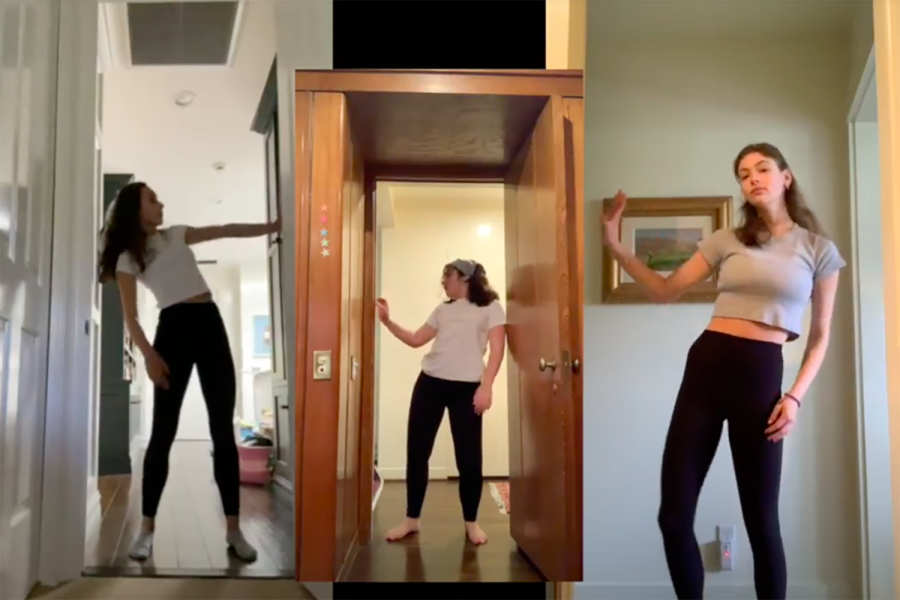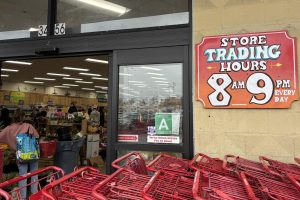Annual Festival of Dance: Overcoming obstacles and finding hope
Photo credit: Thea Leimone
Dancers Cara Banks, Chloe Terani and Daisy Marmur perform in doorways in an edited piece streamed during the remote Festival of Dance. The doorways were used as framing to represent the isolation people have faced this past year.
May 26, 2021
Dancing between doorways, synchronized Zoom squares and self-made music. These are some of the many elements that made up this year’s Festival of Dance, streamed during Practicum lunch on May 14. With a total of 17 student-choreographed dances, performances included solos, small and large groups across all grade levels.
The festival served as an opportunity for students to explore choreographing their own dances while also getting the opportunity to work together with their peers after performing the Night of Dance. Typically, the festival takes place on a stage in the courtyard during the school day for the Archer community to watch and cheer on dancers towards the end of the year, but this year the school chose to make it virtual.
“You definitely can’t replicate the magic that happens on stage, but I feel like all the choreographers in these dances were still so incredible and especially with all the challenges and all these obstacles [they] had to face,” choreographer Lacey Thompson (’24) said. “It was still so amazing to watch everyone create these dances.”
The first dance of the show was titled “Come Down,” choreographed by senior Tove Jegéus and performed by advanced dancers and fellow seniors Lexie Ben-Meir, Aniyah Shirehjini, Zahara Umoja and Jegéus. The dancers spent four class periods choreographing, rehearsing and recording the piece, and it was the only dance where dancers performed in the same space.
“The song ‘Come Down’ was about being on top of everyone else and not being able to go back. And I think that shows a lot of being a senior and we’re at the top, and we can’t go back,” Jégeus said. “[High school] is all over, but it was a very positive look at that, instead of negative, and we’re just going to keep going forward.”
For other dances, students developed a dance concept, which they then submitted, and the class voted on their top choices. Multiple dances drew theme and inspiration from the isolation that the COVID-19 pandemic brought about this past year. Eighth grader Julianna Hatton choreographed and performed multiple dances in the festival, one of them being a collaborative piece with Allie Yang (’25) that followed a story arc of isolation and hope.
“We use spoken word from our dancers to try to add to the story of being stuck at home. Each [dancer] chose something that they [thought] signified being home alone, stuck with only objects instead of people, ” Hatton said. “We have more hope in that the spoken word transitions into being happier and more hopeful for the future. We filmed them in person, which I feel highlighted the helpfulness of being together – being without the objects.”
While dancers had the freedom to edit their pieces together, choosing transitions and being able to edit or redo mistakes, there were challenges in teaching choreography to the other dancers over Zoom with wifi, sound and camera obstacles. Choreographers had less than two months to put their pieces together following the Night of Dance.
“It was pretty weird because the first half of the time I was teaching [my dance] on Zoom was really hard because sometimes people would have their cameras off, and I wasn’t sure if they were getting [the choreography] or not,” freshman Chloe Terani said.
The virtual format gave the choreographers and dancers the liberty to explore different forms of presentation and dance style. Consisting of solos, small and large groups, some in costume and some with outside props or filters, the virtual festival also allowed dancers to be able to view and appreciate the show in its entirety, and to see their own work at the same time the rest of the audience saw it.
“I think I was really surprised with the diversity in dancers’ styles and editing techniques. I think that provided more variety to what was happening and made it more intriguing to watch,” Hatton said. “I do think that, because of the student choreographers, I was able see how we each have our own little niche in this larger umbrella of dance and how we can come together and make this beautiful show. Before, we may not have been able to realize that because we would have been so focused on ourselves and wouldn’t have been able to watch the best dances that were performed.”
At the end of the show the current dance troupe leaders announced next year’s dance leadership team, with senior captains Emily Cadenas and Sophia Farmer. The festival’s final moments served as a celebration for what the senior dancers have accomplished and what the upcoming dance leaders will achieve.
“It just kind of showed me that even if we can’t do it together, we can do it. It still turned out really good, and I was really proud of what everyone did,” Jegéus said. “I feel like we got a pretty big turnout in the meeting itself, which showed that other people like care about what we make and they wanted to see it, which was really special.”









